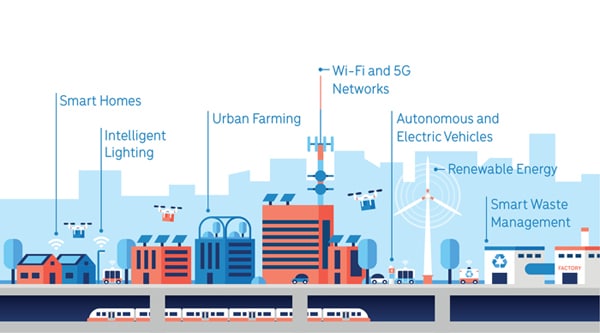The government of India introduced the National Smart Cities Mission to develop smart cities pan India, making them citizen-friendly and sustainable. It said that the goal is to initially include 100 cities, with the deadline for completion of the projects set between 2019 and 2023
The main objectives of creating a smart city environment was to optimise decision-making, creating infrastructures, and the orchestration of cyber and physical resources to address the existing challenges in urban areas. Enhancing the use and benefits of next-generation 5G, IoT, and edge by adding support for tactile internet applications would inspire living standards. However, the large-scale deployment of cyber-physical-social systems using open source has its own series of challenges that may require much more smart sensing and computing methods, advanced networking, and communication technologies to provide more pervasive services.
 Shaping the next-gen networks
Shaping the next-gen networks
Gone are the days when 5G, IoT, and edge computing were just buzzwords. In today’s business verticals, they are quite the reality. Open source is shaping large areas of technology. For example, in telecommunications it is not just a way to foster collaborative research and innovation but an opportunity to make real change in the telco ecosystem. Open source projects are used as major components to create technology that would drive the evolution of the next-generation mobile networks that are vital as industries move towards the 5G era.
The focus is more on the open source platforms and their elements. “It is interesting to know that 80% of telecom data is non-differentiated and can be used as an open source. Instead of falling into it and just consuming it, we can use the best it offers,” says Dr Aloknath De, CTO, Samsung India.
The concept of collaborative development on networks and new technologies is not new in telecom. “Samsung uses the Tizen platform to build digital appliances and Jerryscript from javascript intended to run on a very constrained kind of environment. It also supports IoT and open connectivity foundations,” Aloknath says. Moreover, when it comes to 5G communication, he considers open random access network (O-RAN) and open networking automation platform (ONAP) as two big elements. Akraino is also an important element that supports high availability of cloud services, spanning a variety of use cases bringing artificial intelligence.
Fundamental shift in architecture
Industries are looking at product consumption, architecture software, modularity of software network functions, application services, and use of open source, showcasing a major shift in architecture.
Subodh Gajare, Lead Architect (5G and IoT Security), Cisco R&D, feels that nowhere between 2G and 4G did we witness such major architectural shifts. He says, “When we look at 5G on a silo compared to three previous generations of mobility, we see a fundamental shift in architecture in the way network components were looked at and the security element that has been blown apart.”
In specificality to open source Gajare adds, “So it (open source) is something that starts all from the client and merges on the telco DC side. We are witnessing three major architectural shifts, and this is the place where 7 trillion devices to the 7 trillion people and all these economies of scale will be met. And that’s why it’s both a huge competitive advantage and a huge secondary challenge as well.”
Innovation in open network ecosystem
Gnanapriya Chidambaranathan, AVP & Senior Principal Architect, Infosys, says open networking is bringing in innovation, embracing the cloud nativeness, and dynamic orchestration and automation of network slices, bringing closed loop assurance and exposing open APIs for ecosystem integration.
For instance, all of us are connected remotely and enterprise workloads are moving from the data centres to the edge. Similarly, when we talk about the industry verticals, whether it is manufacturing or Industry 4.0, a lot of low-latency analytics and insights are required. And from a consumer perspective, users can watch high-definition video live streaming and the immersive experiences.
“There are a variety of possibilities that exist today. Open source brings in that openness and helps in driving innovation, cost-efficienctly,” she says. RANs enable physical access to devices and were mostly developed as complete proprietary solutions. This means that it was difficult for innovations to happen at the same pace as the rest of the market.
“We are looking at the The Linux Foundation solution set, ORAN ecosystems, open stack and Kubernetes solutions. There is also the Open Networking Foundation (ONF) where there are a set of open source platforms that exist. We are also looking at how DLT can be leveraged for smart contracts as the business models and monetisation is also important,” Gnanapriya states.
Creating revolution
Open source has been a revolution over time and solutions like Linux and Android are part of our life already. According to experts, it is playing a key role in the next phase of revolutionising the data centre market. For instance, a lot of infrastructure for hyperscalers like Google and Facebook runs on open source.
“We may not be aware that there are companies selling commercial networking products using open source to the data centre and cloud market. The next phase of the data centre evolution is the orchestration with OpenStack, Kubernetes,” says Abhijit Chaudhury, Founder and CEO, Niral Networks.
Acknowledging the pivotal role of 5G, IoT, edge and telecom, Abhijit says there are multiple initiatives for open source disaggregation happening in the 5G for RAN, Core, and Transport. “There have been a few smaller commercial 5G deployments using open source, but I think five/six years down the line there will be huge momentum towards open source based commercialisation in the telecom and the private cellular network for industrial/IoT use cases,” he adds.
Disaggregating components
When 5G came into existence, the thought process of disaggregating the components had already begun. With the arrival of open RAN and the disaggregated components talking to each other on open interfaces, the possibility of doing a lot of telecom applications in RAN and transporting domain to become smaller components that can be handled in isolation opened up.
“These are components that you can innovate upon and bring a lot of value into before you put them together to create a larger solution. So, from the service provider perspective, these are great developments,” says Manish Gangey, SVP and Head, R&D, Airtel. He also points out that one of the big problems in India is that we have a low ARPU (average revenue per user) in comparison to any other place. “So, the way we need to build our own infrastructure has to be thought about differently for any company to be profitable.”
Open source fits beautifully in an association like this by reducing the overall cost of ownership, accelerating innovation, and bringing in many more players into the market. “I look at open source as a great enabler for the Indian ecosystem to develop,” says Manish.
Transforming industries
Dr Inder S. Gopal, CEO, Indian Urban Data Exchange, says there is evidence that open source can transform an industry. “If we look at data centre networking at the time of SDN and NFV, it was dominated by proprietary solutions, whereas now, when the boxes that have been deployed there are looked at, 80% of them are white box solutions, running for the most part open source software. The open source commercialisation has been driven by the availability of open white box hardware alternatives and mature open source offerings, and that has really transformed the data centre,” he explains.
Gopal expects to see a similar kind of transformation in the telco space as well, though it might take a little longer. “I think telcos always move a little bit more slowly than other sectors, but it definitely will happen and there is evidence that it can happen.”
Oops! This is an EFY++ article, which means it's our Premium Content. You need to be a Registered User of our website to read its complete content.
Good News: You can register to our website for FREE! CLICK HERE to register now.
Already a registered member? If YES, then simply login to you account below. (TIP: Use 'forgot password' feature and reset and save your new password in your browser, if you forgot the last one!)







